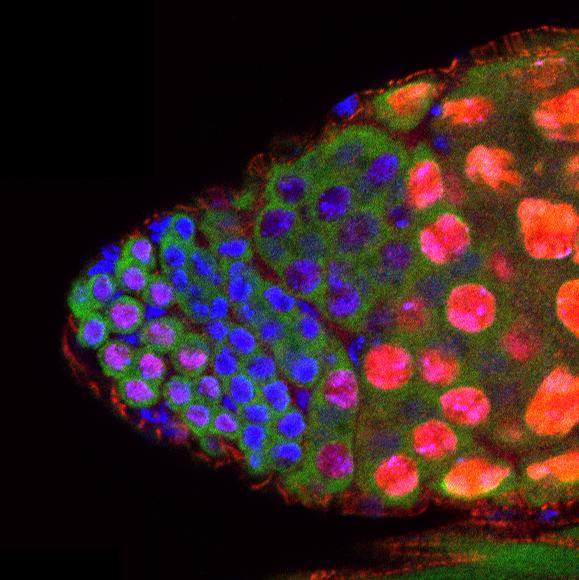BigH1 — The key histone for male fertility

In red, BigH1 expressed in germ stem cells and spermatocytes. In blue, the cell nuclei. Credit: Albert Carbonell, IRB Barcelona.
Depending on the stage of the process, histone BigH1 is either present and represses specific genes or it is inhibited to allow gene expression, thereby promoting differentiation, a process in which stem cells produce adult sex cells. When this delicate balance is lost, male Drosophila melanogaster show gonadal malformations and infertility.
“We hypothesize that BigH1 represses the genes that are not specific to the germ line (when stem cells give rise to sex cells). But we now have to unravel how it does this and how it is activated and silenced,” says Ferran Azorín, CSIC Research Professor and group leader at IRB Barcelona.
The role of histone H1 in male infertility
All animals have histones that are specific to the germ line. In Drosophila, BigH1 is expressed in the male and female germ lines. In contrast, variants of histone H1 differ between males and females in mice and in humans.
“The histone BigH1, which we have studied in Drosophila melanogaster, shows most resemblance to the germ line variant of human females but it also shows some similarities to variants of the male germ line,” explains Albert Carbonell, postdoctoral fellow and first author of the paper. “Because of these similarities, our work can contribute to our understanding of sex cell diferentiation in humans and help to explain some types of infertility,” he adds.
Histones as regulators in stem cell differentiation into tissue cells
All the cells of an organism, whether skin, intestinal, lung or any other type, arise from the differentiation of stem cells, and it is known that histones play a crucial role in this process in many lineages. This study describes the mechanism of action and inhibition exerted by BigH1 to regulate spermatogenesis in Drosophila and which may work in a similar manner in other species.
The lab is now focusing on BigH1 during the differentiation of female sex cells. “We know that this histone is essential, but we assume it will have a distinct role since the process involving female sex cells is considerably different to that of male ones,” says Paula Climent, a PhD student in the lab and one of the authors of the article.
###
The research was supported by funding from MINECO, through ERDF, and from the Catalan Government.
Reference article:
The germline linker histone dBigH1 and the translational regulator Bam form a repressor loop essential for male germ stem cell lineage differentiation?
Albert Carbonell, Salvador Pérez-Montero, Paula Climent-Cantó, Oscar Reina and Fernando Azorín.
Cell Reports (2017) DOI: http://dx.
Media Contact
All latest news from the category: Life Sciences and Chemistry
Articles and reports from the Life Sciences and chemistry area deal with applied and basic research into modern biology, chemistry and human medicine.
Valuable information can be found on a range of life sciences fields including bacteriology, biochemistry, bionics, bioinformatics, biophysics, biotechnology, genetics, geobotany, human biology, marine biology, microbiology, molecular biology, cellular biology, zoology, bioinorganic chemistry, microchemistry and environmental chemistry.
Newest articles

NASA: Mystery of life’s handedness deepens
The mystery of why life uses molecules with specific orientations has deepened with a NASA-funded discovery that RNA — a key molecule thought to have potentially held the instructions for…

What are the effects of historic lithium mining on water quality?
Study reveals low levels of common contaminants but high levels of other elements in waters associated with an abandoned lithium mine. Lithium ore and mining waste from a historic lithium…

Quantum-inspired design boosts efficiency of heat-to-electricity conversion
Rice engineers take unconventional route to improving thermophotovoltaic systems. Researchers at Rice University have found a new way to improve a key element of thermophotovoltaic (TPV) systems, which convert heat…



